

Showing posts with label festival. Show all posts
Showing posts with label festival. Show all posts
Thursday, May 29, 2008
Thathayagunta Gangamma

Labels:
crown,
deity,
festival,
folk,
Gangamma,
goddess,
Gold,
lord,
management,
prayers,
public,
Sister,
temple,
Thathayagunta,
Time,
Tirupati,
traditional,
venkateswara,
vows,
Woman
Tuesday, May 27, 2008
Melkote or Tirunarayanapuram - Another important pilgrim center that is close to Mysore

Another important pilgrim center that is close to Mysore is Melkote or Tirunarayanapuram. Melkote is about 60kms from Mysore city and is located in a hilly region that comprises some of the oldest rock formations on earth. Cradled in the middle of these hills is the temple town of Melkote. This town gained religious importance in the 12th century AD when the famous South Indian Vaishnava philosopher and teacher, Sri Ramanuja lived in Melkote for around 12 years.
Melkote is nearing to Mysore in Karnataka houses an ancient shrine to Vishnu, worshipped as TiruNarayana. This shrine is known for its long standing association with the spiritual leader Ramanujacharya. Melkote is also known as Yadavagiri, yatistalam, Vedadri and Narayanadri.
Melkote is located in the Mandya district, Karanataka State in South India. It is around 30 kms from Pandavapura, 25 kms from Mandya and 160 kms from Bangalore (3 hours drive appx). It is at an altitude of about 900 metres above the sea level. The place has a very long history, dating back to "Kritha" Yuga, when it was called "Vedadri". In "Thretha" Yuga it was called "Narayanadri" and in "Dwapara" Yuga was called "Yadavadri". The main deity Cheluvanarayana, is known to have been worshipped by Sri Krishna and Balarama in Dwapara Yuga. In "Kali" Yuga, Acharya Sri Ramanuja, reinstalled the deity and the place came to be known as "Yathisaila". Melkote is equated to the famous Badarinath, and is called Dakshina Badari Kshetra. (South Badari)
Life in Melkote is centered around the Cheluvanarayanaswamy temple in the town and the Yoganarasimhaswamy temple on the hill overlooking the town of Melkote. It is these temples that have made the town a popular tourist attraction. These temples have helped to preserve the tradition of the town and at the same time is a repository of all the knowledge of culture. The temple premises houses the oldest Sanskrit Pathsahala in India that dates back to 1853.
The School continues to provide instruction in Sanskrit and Indian Philosophy. As a result of this rich cultural and traditional heritage it has been found that Melkote has managed to retain its traditional nature over the centuries. Studies have shown that there has been very little change in the town of Melkote. The changes have been minor whether in the town plan, type of houses or cultural practices. So visiting Melkote is like visiting our cultural heritage in its living form.
The festivals held at the temple involve the entire town. Some of the important festivals held in the temple are the Vairamudi Utsava, Teppostsava and the birthday or Tirunakshtram celebrations of important saints. What is unique about Melkote is that some folk festivals like the Angamani festival have been integrated into the temple rituals thus making all celebration meaningful to the common people.
The presiding deity here (moolavar) is known by the name Tiru Narayana, while the processional image of Vishnu goes by the name Selva Pillai or Sampath Kumara. Vishnu's consort is known by the name Yadugiri Taayaar. The image of Selvappillai is housed in the Rangamandapa. There are shrines to Yadugiri Taayaar and Kalyani Nachiyaar. The temple tank is known by the name Kalyani theertham.
Legend has it this image of Vishnu was held in worship by Bhrahma. It is believed that the festival image Sampatkumara was worshipped by Rama and his son Kusha; hence the name Ramapriya. Legend has it that Krishna installed this image here at Melkote.
Melkote has two distinct temples. The Tirunarayana temple at the foothills and the hill temple to Yoga Narasimha. Legend has it that the Yoga Narasimha temple image was installed here by Prahlada.
King Bittideva of Karnataka who embraced the Sri Vaishnava way of life and patronized the saint Ramanujacharya, assumed the name of Vishnuvardhana and built five shrines known as the Panchanarayana temples. It is believed that at that time the Narayanapura shrine was in ruins and that both the images of Tirunarayana and Sampathkumara were missing and that Ramanujacharya discovered the image of Tirunarayana in the midst of Tulasi shrubs on the Yadavagiri hill and installed it back in the temple.
Legend has it that during the Muslim raids of South India, the festival image of Melkote was stolen and taken away and that Ramanujacharya restored it from the court of the ruler. It is said that it a muslim princess had gotten attached to the image of Selvappillai and that being unable to part with it, she followed the Acharya to Melkote and then merged into the shrine there. In honor of this, there is an image of Bibi Nachiyar here.
This temple is known for its Vairamudi Sevai in the month of March-April, when the image of Selvappillai is adorned with a diamond crown and taken out in procession. It is traditional belief that this crown is not to be looked at when it is not worn by the festival image; hence each year, during the occasion, the officiating priest picks up the crown from its chest with his eyes blindfolded and then places it upon the head of the image of Selvappillai. Thousands congregate to celebrate this occasion each year.
Such was the hospitality of the residents of Melkote that they were reluctant to let Ramanuja leave for Srirangam. Hence, Ramanujacharya made an image of himself and left it behind. It is to be noted that Ramanuja's body in its preserved state is maintained at Srirangam and that there is another image of Ramanuja at Sriperumpudoor near Chennai.
Saturday, May 17, 2008
Ramayana
Ramayana is one of the two major Sanskrit epics of ancient India, the other being the Mahābhārata. Along with the Mahābhārata, it forms the Hindu Itihasa. The epic, traditionally ascribed to the Maharishi Valmiki, narrates the life of Rama, the legendary prince of the Kosala Kingdom.
Ashok vatika where Ravana kept Sita
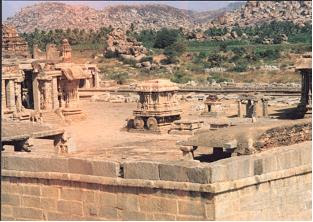
The Ravana Palace which was burnt by Hanuman
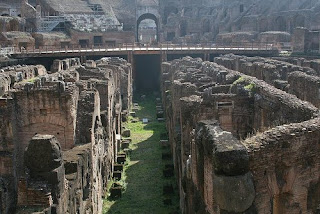
Sugriva Cave
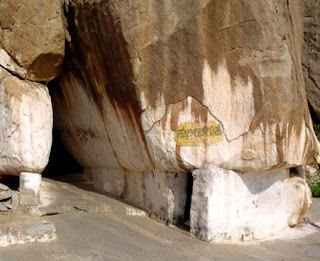
Sanjivani Mountain from where Sanjivani Booti was acquired to save Lakshman which has many exotic herbs even now
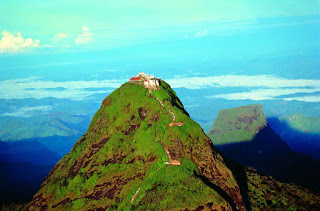
Floating Stone from Ramsethu
(bridge made by lord Rama and Vanara sena)
.jpg)
Ramsethu
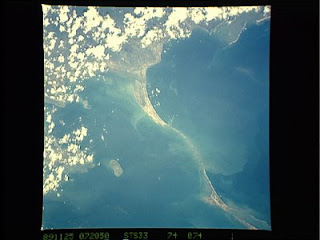
Also See











